Per Chris Grinter, l'1 de juliol, 2010 I ara per a la sèrie encara més infreqüent que ocorre de nou, La veu del poble! Per als que no tenen records cicatrització de l'escola secundària de classe llatí (per causes alienes a la meva professor) Vaig a portar fins velocitat – el títol es podria traduir com “veu del poble”. Aquí és un altre vell correu electrònic que he estat estalviant. És una 100% real message, but of course I have redacted the real names and addresses to protect the innocent. Enjoy! I also highly encourage submissions of your own-
Winter 2008:
“Hola, I’m so glad I found you. Ara, I hope you can help me. 1982, while camping at an old gold mining camp in the Mendocino National Forest I was bitten by a large brown spider. It took three days for the venom to pass through my system. On day three I was 95% blind, the bite swelled to a large grotesquely deep red bump on my arm. I’ll never forget the 12 hours the venom attacked me. The price I payed to survive this spiders venom was…….to loose absolutely all my body fat. I spoke with a doctor from Santa Rosa by phone from a friends place in (some small CA town). He knew about this spider and couldn’t believe I suvived the venom when I told him I lost all my body fat. He also told me it was impossible for someone to survive loosing all their body fat in 12 hores. I reminded him that this was an impossible situation. He told me that this spider is being kept from the public. I believe this spider came from China or Russia. These spiders don’t share anything with other Cali spiders. They have big bodies and short stout legs. The female that bit me was about 4 inch’s and, had 5 males. Four years later, while living in the Hayward hills, I couldn’t believe my eyes, running across the floor, another one. This spider was about 6 inch’s. I know these spiders don’t climb walls or spin webs. They build nest’s, and obtain 4-5 males to protect her and find food. The female never leave’s the nest except…………when a larger female drives her out and, kills her males. This is when people are bitten by this spider, as she runs around looking for another nest. Bites are very uncommon. I wondered………….how big was the female that drove that 6 inch from her nest. I………….how big do they get. Can I find this spider on display at (your museum)? Is it possible to find all the information their is on this very dangerous spider?”
Continue reading Vox Populi, volum II
Per Chris Grinter, on June 26th, 2010 Welcome to volume eight of the inconsistently reoccurring series, Geni de la Premsa. Em vaig trobar amb this article recently regarding an endemic Puerto Rican butterfly. Who can tell me exactly why this report is misleading? It may be a little trickier than the standard GOP (I suggest discarding any previously associated acronyms with those letters). Hint, just telling me the butterfly in the picture is from Malaysia is not the answer I’m looking for!
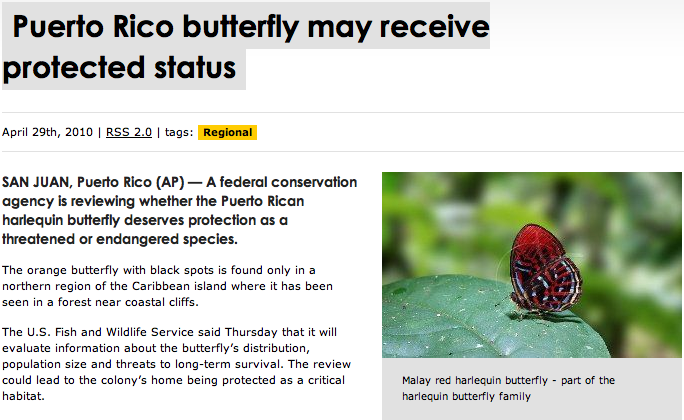
Per Chris Grinter, el 23 de juny, 2010 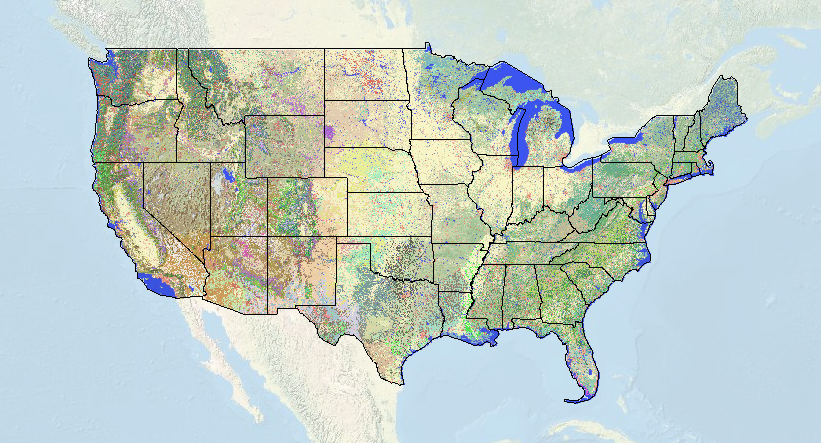
Sempre m'he preguntat com trobar la terminologia correcta per a la cobertura del sòl en una àrea determinada. Generalment, Acabo de buscar alguna cosa semblant a “xaparral d'alzina”. Però ara puc utilitzar això nou mapa fantàstic que ens ha aportat la USGS/National Biological Information Infrastructure. El nivell de detall és sorprenent, i podeu especificar el grau de precisió amb una pestanya desplegable (1-3). Ara, amb un mapa topogràfic dels Estats Units d'alta definició, puc veure exactament on es troben els rodals més grans de pi de Monterrey (en realitat és un Bosc i bosc de coníferes de con tancat costaners de Califòrnia) així puc col·locar de manera òptima la meva trampa aquest cap de setmana.
Continue reading Landscape Cover Map
Per Chris Grinter, on June 18th, 2010 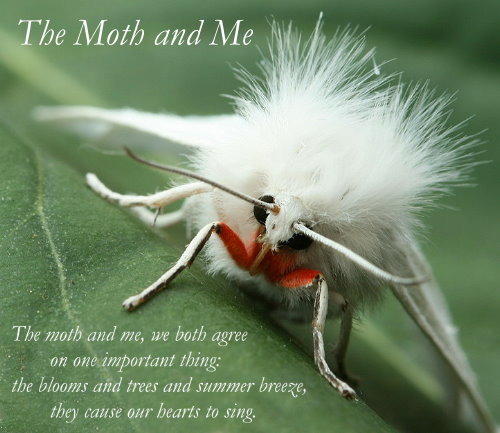
Welcome to The Moth and Me #12, and my first blog carnival. Despite blogging for a few months I have yet to take a look back and reflect on exactly how I became enamored with lepidoptera in the first place. Remembering a time or location where this happened is impossible, and like many of my colleagues and I’m sure many of my readers, I had a butterfly net and “bug cage” in hand as soon as I could walk. When it comes to entomology I believe almost everyone falls in love at first with a large and striking insect. For me it was a butterfly, naturally. I can remember staring for endless hours at the diversity of Ornithoptera and Papilio illustrated in Paul Smart’s famous book. Somewhere along the way in pursuit of something new I began to stray into the nocturnal world. Moths comprise the majority of the diversity of Lepidoptera; while there are nearly 11,000 species in the United States, only a few hundred are butterflies. This quickly opened a door (maybe into an abyss…) to the shocking abundance found everywhere around us. This amazing diversity has now drawn me deep into the biology and evolutionary history of the Lepidoptera. Editing these fourteen contributions of moth blogging together I just can’t help but to reflect back on some of my own mothing journey.

perhaps if I was a child in Europe this moth (Deilephila elpenor porcellus) would have been the first to catch my eye. Over at Urban Moths Ron Laughton has discovered the stunning diversity in his own back yard in much the same way as I did growing up here in the US. Take a look at the types of traps he has been using, most of which he constructed himself. One of the best behaviors of moths is their willingness to dive headlong into the light. Not too far from Ron, Mike Beale has been blogging british moths as well. It can be pretty amazing just how similar our two faunas are (a few moths actually are the same).
Continue reading The Moth and Me #12
Per Chris Grinter, l'11 de juny, 2010 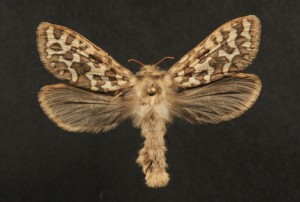
Aquesta arna és gairebé tan rara com el seu homònim paranormal (excepte que és real) – és un Gazoryctra sp. de la família Hepialidae. Representen un llinatge basal dels lepidòpters i es coneixen comunament com a arnes fantasma o arnes ràpides.. Fantasma – perquè se sap que els mascles d'algunes espècies volen en veritables leks, on planegen amunt i avall en clarianes herbades al capvespre mentre les femelles observen. Aquests mateixos mascles també demanen femelles amb feromones, una situació una mica endarrerida amb els insectes. Ràpid- més aviat evident, però se sap que les espècies boreals són poderoses voladores.
Una de les característiques que ajuden a indicar-ho com a llinatge basal és la col·locació de les ales al cos, alguna venació d'ala, peces bucals reduïdes o absents i la manca d'un dispositiu d'acoblament d'ala fort. Aquestes arnes tenen a “jou”, que és un petit polze com una projecció des de la part superior de l'ala posterior. Altres llinatges d'arnes tenen un mecanisme d'acoblament estret conegut com a frenillo i retinaculum, on les truges uneixen les dues ales perquè romanguin acoblades durant el vol. Quan està en repòs, el jugom es doblega i probablement ajuda a mantenir les ales juntes – però no durant el vol; l'ala anterior està dessincronitzada amb l'ala posterior i el vol no és dinàmic (Però quantificar aquestes teories i explicar com i per què passa això és exactament el que tracta la ciència 1992).
A les Amèriques la biologia dels hepiàlids és molt poc entesa. Només un grapat d'històries de vida es descriuen globalment – tots ells semblen endofags (avorrit) en els sistemes radiculars de les plantes. Algunes larves primerenques poden alimentar-se a la fullaraca o sota terra del sistema radicular abans d'entrar al rizoma.. Austràlia té la sort de tenir una fauna diversa i impressionant d'Hepialidae – molts ho són de colors brillants i enorme (250mm o fins a 12 polzades!), i una mica millor estudiat. Algunes larves són fins i tot prou comunes que les tribus aborígens les han utilitzat com a font d'aliment bàsic.
Però tornem a aquesta arna en particular. El vaig recollir a la meva trampa de llum negra l'agost passat a Sierra Nevada 10,500 peus. Es desconeix l'espècie, i pot ser que sigui nou. La part més frustrant és que és l'únic exemplar conegut per la ciència. Tot el gènere és molt rar, excepte una o dues espècies comunes, només existeixen unes quantes desenes d'exemplars. Així doncs, és una femella d'una espècie descrita només a partir d'un mascle? Una aberració estranya d'una espècie d'altra manera coneguda? O potser és realment nou. He codificat de barres l'ADN, això en realitat no em diu res, ja que hi ha zero seqüències de qualsevol espècie estretament relacionada. En realitat, pel que jo sé, les altres espècies de la Serra ni tan sols s'han recollit durant dècades, així que ni tan sols puc obtenir una seqüència d'un exemplar més antic.. La cirereta del pastís és el seu comportament. Poques vegades, si algún cop, sortir a la llum – que pot ser conseqüència del seu vol crepuscular. A la nit correcta poden estar a l'ala per 20-30 minuts, generalment una dona busca un mascle, o una femella que vola a ovipositar (probablement només emet escampar els seus ous a terra). Així doncs, a finals d'agost, tornaré a la serra alta amb uns quants voluntaris del departament d'entomologia amb l'esperança de veure'n un xiullet al meu costat als pendents pronunciats.. Si en tinc més, podria resultar ser una espècie nova impressionant per a Califòrnia.
Per Chris Grinter, l'11 de juny, 2010 Who can see what’s wrong with this article?

Per Chris Grinter, el 9 de juny, 2010 
Això article recent a l'American Naturalist ha fet un segon cop d'ull a algunes de les famoses estimacions d'espècies inflades, alguns van alt com 100 milions (Erwin, 1988). Les estimacions realitzades pels autors indiquen que les projeccions anteriors 30 milions tenen probabilitats de <0.00001. És més probable que el seu rang estimat estigui entre 2.5 i 3.7 milions d'espècies (amb 90% confiança). Això sembla una mica raonable atès que aquestes estimacions extraordinàries es basaven en gran mesura en l'extrapolació. És evident que hi ha moltes dificultats per avaluar la diversitat a partir d'enquestes d'artròpodes tropicals – aquest article torna a utilitzar fitòfags (menjar plantes) escarabats per a estimacions. Tenen cura de assenyalar que aquests mètodes no tenen en compte els insectes no fitòfags, però suposar que seguiran els patrons biogeogràfics tradicionals de diversitat. Aquest és un concepte una mica nou, ja que quan estava a la universitat em van ensenyar que els parasitoides són contraintuïtivament no més diversa a les regions tropicals. La majoria de les vegades, aquesta hipòtesi es demostra falsa a la llum d'una metodologia taxonòmica moderna més precisa. Amb força orgull vaig ajudar a jugar un paper amb el projecte parasitoide a la UIUC. En breu, L'especificitat de l'hoste és més extrema en entorns tropicals amb centenars d'espècies críptices amagades entre grups de radiació ràpida com els bracònids microgastrines. (Himenòpters) – el mateix ha passat en tàxons similars.
Una nota interessant sobre el document és la inclusió d'una estimació secundària basada en conjunts de dossers de lepidòpters.. Van suposar que a) tots els lepidòpters es poden trobar al dosser i b) que tots els leps són fitòfags. Aquesta és clarament una estimació molt conservadora atès que no tots els lepidòpters es troben al dosser i no tots són fitòfags.. Encara que no tinc els números a mà, d'aquestes estimacions s'ha d'haver exclòs un determinat percentatge de diversitat de lep. També sortiré en una extremitat i suposaré que els autors (Novotny 2002) no incloïa morfoespècies de microlepidòpters – i molt probablement abundàncies estimades amb la nostra comprensió taxonòmica actual. Tanmateix, no tinc accés a això 2002 paper, així que puc estar equivocat. Utilitzant aquests nombres de lepidòpters (de la mateixa enquesta que els coleòpters) una diversitat global va ser estimada per Hamilton et. al. al voltant 8.5 milions d'espècies d'artròpodes.
Tot i que estic d'acord que les estimacions extraordinàries de desenes de desenes (o centenars) de milions d'espècies d'artròpodes són probablement ridícules; Sóc del camp que les investigacions actuals indiquen que les estimacions de les desenes de milions d'espècies més baixes són possibles. Els autors no han inclòs investigacions que contrapesin la seva premissa que les espècies tropicals presenten una diversitat beta més baixa. (Novotny 2002, 2007). En el mateix diari, Naturalesa 2007, Dyar et. al. han indicat que els tròpics americans presenten una diversitat beta més gran del que s'havia suposat anteriorment. O bé es pot dir que les estimacions de la diversitat beta als tròpics australàsics són incorrectes, o són incompatibles amb els conjunts d'espècies dels boscos neotropicals. Tot això parla de la dificultat d'extrapolar les estimacions d'espècies a totes les regions tropicals. Aquestes estimacions es basen en estudis exhaustius d'insectes de Nova Guinea, potser no reflecteixen amb precisió la veritable diversitat dels boscos tropicals americans, i aquests intervals de nombres són baixos.
Com a reflexió final, la majoria de les avaluacions se centren en artròpodes tropicals. Sembla molt possible que el nombre total de totes les espècies, incloent bacteris i arquees, pot superar fàcilment desenes de milions. Però extrapolar aquestes xifres és encara més precari que els artròpodes, donada l'extrema manca de coneixement que tenim.
Per Chris Grinter, el 4 de juny, 2010 
No trobo cap manera d'enllaçar el vídeo directe (ni tan sols VodPod), però aquí està el enllaç al lloc del Daily Show. Quants físics es van treure els cabells quan van sentir això? Vaja, és el portaveu acabat de nomenar. no et preocupis Neil, després d'això no aniràs enlloc.
En no haver-se emès encara no puc dir exactament fins a quin punt em disculpo el xou és, però sembla molt centrat a trobar el “creador”. Ho escolto a la veu de John Stewart quan es retira d'entrar a la de Freeman “déu dels buits” teoria. Potser hi va haver una edició i ens vam perdre la pregunta que va fer John Stewart “Morgan, pots definir una fal·làcia lògica per a nosaltres?… potser el déu dels buits?” Crec que qualsevol físic que ho digui “Déu era responsable” ho diu sense un significat més profund que quan Einstein va evocar els daus de Déu. És a dir, un déu no literal i no personal que només es troba en la bellesa i l'esplendor de la natura.
Per Chris Grinter, el 2 de juny, 2010 
Si hi ha alguna cosa que he après a la universitat, era com distreure'm fàcilment. Acostumo a mantenir el televisor encès en segon pla mentre treballo a l'ordinador, sobretot a la nit, quan normalment estic lluitant en una guerra guanyadora contra el son. The other night something did catch my eye: a man holding dowsing rods in his back yard. Volume up, let the bullshit flow. It was just a flash of idiocy in an otherwise good program on home improvement. I’ve become accustom to crap-based TV on networks such as the History Channel or a Discovery network (quality of their shows include gems like “The Haunted: ghosts and pets”), but I was a little surprised to see BS grace my local PBS station.
Over on the “American Woodshop” host Scott Phillips was constructing a beautiful garden arbor. You can watch the entire thing here for free: Episode 1609: Period Architectural Moldings and Trim. There are no time stamps on the clip, but the dowsing comes in around the mid-point. While demonstrating the materials needed to secure the wood to the ground he cautioned against digging haphazardly into your yard without knowing where the underground water, electrical or gas lines were: solid advice. So in order to do this you should (parafrasejat) “take pieces of coat-hanger, anything will do, turn them into an “La”. As I walk forward the bars cross – allà (they cross) – right there is the irrigation line. 9 out of 10 people have this ability, but you should call in a professional if there is any doubt“. My translation “OK guys, don’t worry about calling in some guy to do this, figure it out this way”. Please tell me what man who seriously watches a home improvement show at midnight would cede authority to someone else before giving it the good ol’ college try? Even if we grant for a moment that 9 out of 10 people could do this, what about that one guy who can’t? Isn’t it irresponsible to suggest that you can avoid power/water/sewer/gas only 90% of the time? Ups, hit that pesky gas line…
Being a scientist, a skeptic and a procrastinator – I wrote Scott a message about this so I could avoid my work at hand. Today he kindly replied saying: (excerpt)
“Our bodies are electromagnetic fields. Disrupt a field and things happen…. I learned the technique mentioned from a city worker that they used to find lines. Not from a charlatan. My team witnessed the objective use of this technique.”
Briefly, no, our bodies are not electromagnets. Everyone can hold a compass, or TV… without screwing them up. Franz Mesmer coined the idea of “Animal Magnetism” in the last half of the 18th century (also invented “mesmerization” AKA hypnotism) – and had it abruptly debunked by Benjamin Franklin and others. I’m also a bit worried to hear that city workers are relying on dowsing to locate public lines! But to move onward, let us dig into the myths of dowsing. I agree that there seems to be somewhat of an intuitive truth when it comes to dowsing, however false it is scientifically, it remains compelling. Clar… electrical things underground effect sensitive wires above. And wow, look at all these guys who can find water, or power, o… lost people… o bombs? Okay, let’s stick to water for this conversation.
(continued)
Continue reading An Uphill Battle
Per Chris Grinter, l'1 de juny, 2010 Just a few images of common California leps, taken along the coast range near Santa Cruz a few weeks ago. Starting to work my way through some photo backlog…

chalcedona Euphydryas
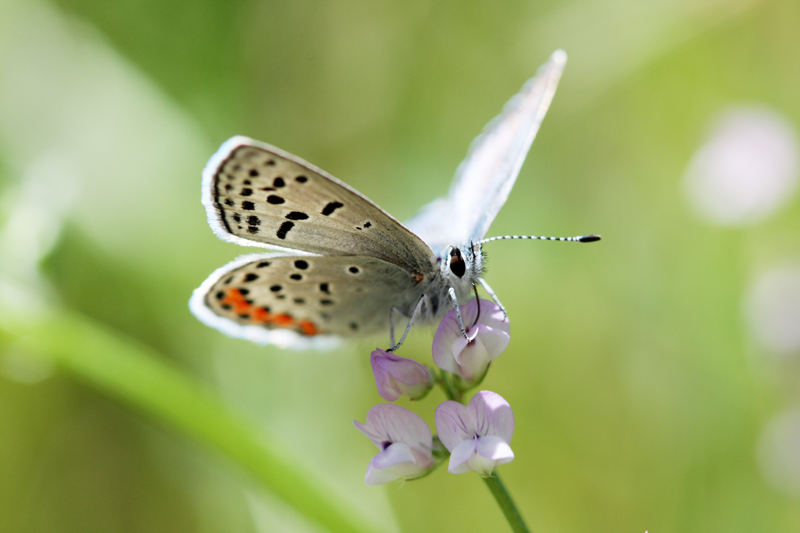
Plebea ACMO
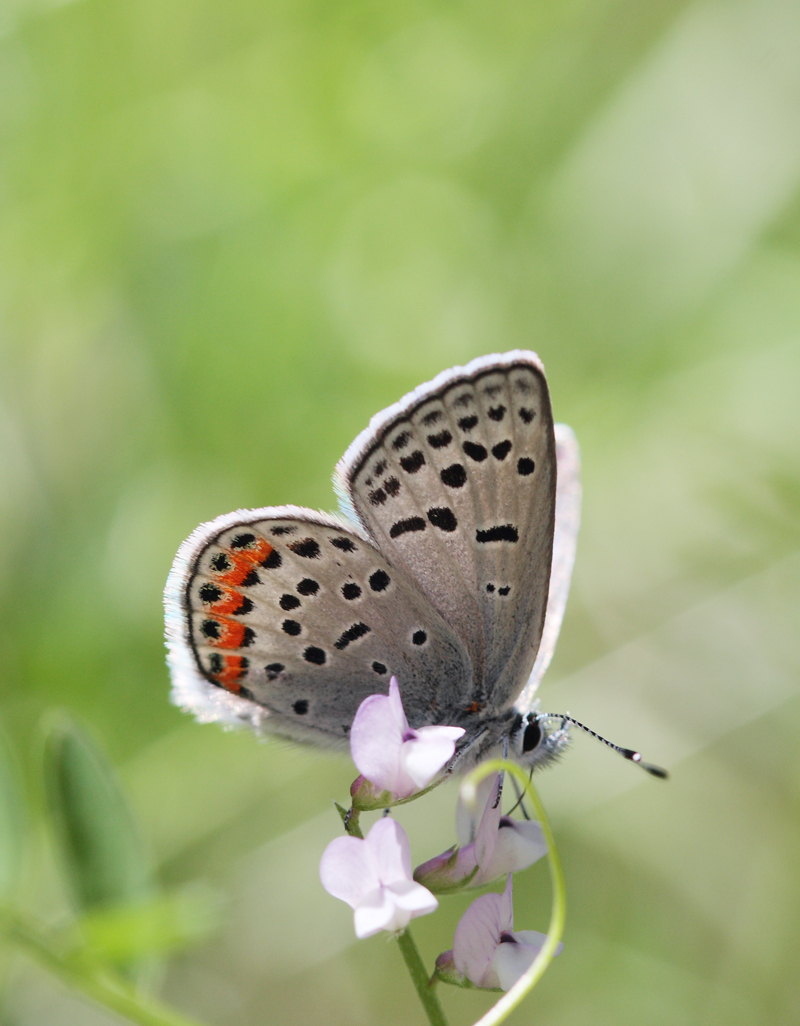
Plebea ACMO

Ethmia arctostaphylella activat Eriodictyon sp.
One interesting note on Ethmia arctostaphylella – the name is a misnomer, it does not actually feed on Arctostaphylos (Manzanita). At the time of description in 1880 Walsingham had found larvae pupating on leaves of manzinata and assumed it was their host plant. In Jerry Powell’s stunning monograph of the group he indicates this moth was reared from Eriodictyon – which happens to be the flower the moth is perched on. The two plants grow side by side, and it’s pretty easy to see how a wandering caterpillar finds its way onto a neighbor.
|
Escepticisme
|













